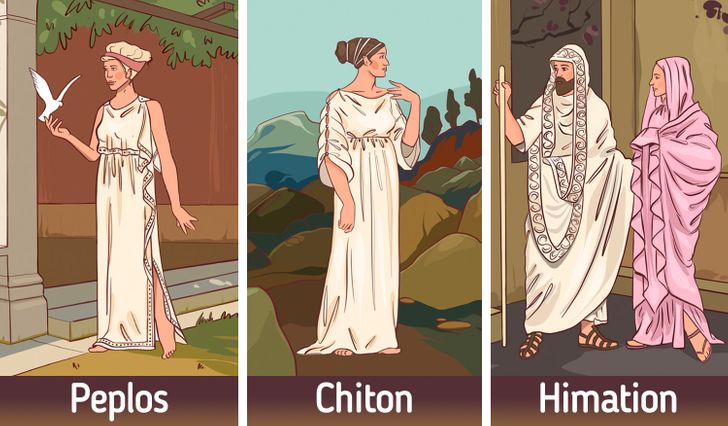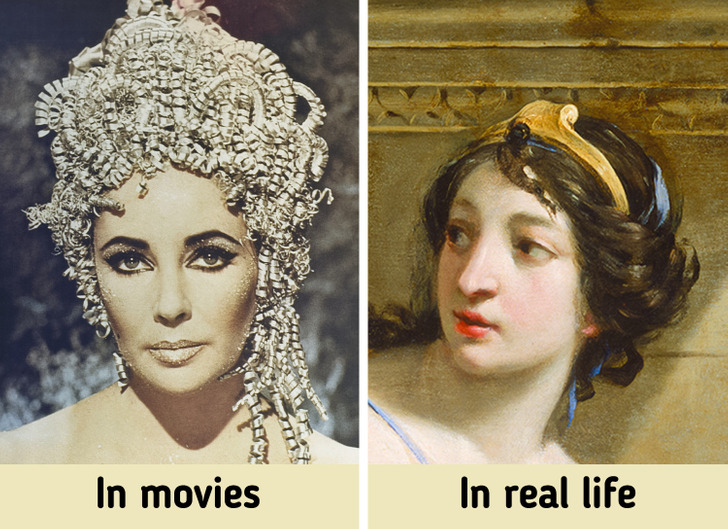10+ Movie Clichés That Give Us the Wrong Idea of Ancient Greece

Although filmmakers are surrounded by numerous consultants who make sure the historical events in movies are accurate, they often still intentionally sacrifice the veracity of a flick for the sake of a thrilling plot or a more colorful picture. It all results in creating misunderstandings about certain events and epochs in the viewers’ minds. At the end of the article, we are going to tell you about the real appearance of Queen Olympias, whose image was (almost) perfectly portrayed by Angelina Jolie.
Women aspired to be thin.

Movies and television series often show slender women of ancient Greece. In reality, in those days, the Greeks considered excess weight a sign of prosperity, and therefore ancient beauties dreamed of gaining pounds. Pay attention: almost all statues depicting women of those times do not show thinness.
Helen of Troy was known for her slender body and bronze skin.
Many legends are devoted to the beauty of Helen of Troy. And it’s not surprising that in movies she is usually played by the most attractive actress at the time. Even though it’s not known for sure what features Helen possessed, it can be confidently said that her beauty corresponded to the beauty canons of those times.
We can assume that Helen of Troy had a low forehead, a large straight nose (without highlighting the bridge of the nose), a slightly upturned chin, and a curvy shape. A History of the Fall of Troy, which has been passed down to us says that the most beautiful of women had fair skin and hair, large eyes, and had a small mole between her eyebrows.
The Spartans had short haircuts.

Many people imagine Spartans as unkempt warriors who didn’t bother with how they looked at all. We were quite surprised to learn that Spartan men thoroughly took care of their appearance.
They paid special attention to their hair, which they would braid. Mentions of thick, mid-back length hair can be found in ancient sources. The popularity of this hairstyle is also proven by the images that have been passed down to us.
Ancient Greek women wore elaborate dresses.
Most movies about Ancient Greece show us female characters in perfectly fitted elaborate dresses with seducing necklines. In reality, things were a bit different.

The main components of an Ancient Greek outfit, for both women and men, were tunics (peplos and chiton) and a cloak called himation. Peplos was a large rectangle of fabric, usually made of wool, folded over along the upper edge so that the overfold would reach the waist. It was fastened with a pin at the shoulders and was often secured with a special belt at the waistline. The sides of the garment were pinned or sewn to form a seam.
The chiton was made from much lighter fabric. As a rule, it was imported linen. This fabric was sewn up at the sides, girded around the waist, and pinned or sewn at the shoulders. Female chiton would reach the floor, and the male chiton was a bit lower than knees.
Himation cloak was worn over tunics. It was either placed on one shoulder or worn like a stole. Women could also wear an epiblema shawl over the tunic. Fabrics were dyed in bright colors and decorated with elaborate embroidery.
Women in Ancient Greece plucked their eyebrows and walked around with their hair down.
In movies, Ancient Greek beauties are seen with their hair down nicely fluttering in the wind, accurately plucked brows, and gorgeous Mediterranean tan. But in reality, things were slightly different. Naturally connected eyebrows, fair skin, and long hair, which married Greek women gathered in a bun, were considered beautiful in Ancient Greece.
In order to get closer to the ideal, women tried to whiten their skin, color their brows with soot, and attach false eyebrows made of dyed goat hair to their foreheads.
Gladiators were athletic.
Studies of the remains of gladiators found in a mass grave indicate that they had a thick layer of subcutaneous fat. This led scientists to assume that the gladiators consumed very little animal protein, and their diet was rich in carbohydrates, which they received through legumes and grains. This explains the funny nickname of Ancient Roman warriors — “barley eaters.”
However, that doesn’t mean authorities were trying to save money when feeding warriors. Based on the conditions in which they lived, it can be assumed that the purpose of a plant-based diet was to increase the warriors’ stamina and resistance. In other words, gladiators were specifically fed carbohydrates so that they would be able to fight better and have more endurance. In order to make up for their lack of calcium, the fighters would consume a special drink based on plant ash.
Gladiators fought to the bitter end at the cost of their lives.
Despite all the things we see in movies, gladiators didn’t always fight to their last inhale. Moreover, this outcome of a fight was considered illegal. There were special rules for conducting fights, as well as judges who were watching to make sure the rules were strictly followed. A lot of funds were invested in gladiators so it wasn’t sensible to lose them so easily (from a financial point of view).
All gladiators were slaves and they were kept in harsh conditions.
Gladiators lived in decent conditions. They had special nutrition and even had access to the services of healers. The warriors were quite popular among locals and were actually kind of celebrities — their portraits would decorate public places, while little boys would dream about resembling the warriors fighting in the arena. In addition, not all gladiators came from the lowest class. There were volunteers among them — free residents who took the gladiatorial oath of their own free will, thereby exchanging personal freedom for a certain amount of money.
Fights were not the usual duels that are shown in the movies. They were a spectacular show with elaborate sets and props. Gladiators would wear intricate and often weird costumes that only vaguely resembled classic armor.
A gladiator’s destiny was determined by a thumb held up or down.
There were some gestures that decided the future fate of the gladiator, but they had nothing to do with the thumb. To show mercy to the fighter, a hand was closed into a fist.
Women wore makeup to highlight their beauty.

Many viewers have an idea of what the women of ancient Greece looked like from the film Doctor Faustus, starring Elizabeth Taylor. But despite the brilliant performance of the actress, the director deceived us. Decent women, especially those of higher casts, never wore makeup. It was simply indecent.
Bonus: What Queen Olympias looked in real life
Looking at the charming Angelina Jolie who played the mother of Alexander the Great, Queen Olympias, we start to involuntarily think that all women in the Ancient world had a perfect nose, plump lips, and chiseled cheekbones. However, the truth is that Queen Olympias was quite far from the image created by Hollywood moviemakers. Judging by the only image of Queen Olympias that has survived to our modern-day, she had a classic Greek profile, a low forehead, an upturned chin, and a soft face.
Which of these facts became a real discovery for you? Perhaps you are aware of other historical myths that are shown to us in movies? Please tell us about them in the comments!







